Contents
Page List
Guide
TAI CHI SECRETS OF THE WU STYLE
Tai Chi Secrets
of the
Wu Style
Chinese Classics Translations Commentary
by Dr. Yang, Jwing-Ming
YMAA Publication Center
Wolfeboro, NH USA
YMAA Publication Center
Main Office:
PO Box 480
Wolfeboro, NH, 03894 USA
800-669-8892
Copyright 2002 by Yang, Jwing-Ming
Edited by James OLeary
Cover design by Katya Popova
ISBN 13: 978-1-886969-17-9
ISBN 10: 1-886969-17-5
All rights reserved including the right of reproduction in whole or in part in any form.
Publishers Cataloging in Publication
(Prepared by Quality Books Inc.)
Yang, Jwing-Ming, 1946
Tai chi secrets of the Wu style : Chinese classics, translations, commentary / by Yang, Jwing-Ming. 1st ed.
p. cm.
Includes index.
Chiefly in English; some text in Chinese.
LCCN: 2002101587
ISBN: 1-886969-17-5
1. Tai chi. I. Title.
GV504.Y36 2002613.7148
QBI02-200165
Contents
Foreword
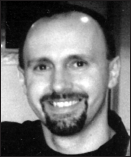
The content of Chinese Wushu ( )(martial arts) is vast and highly diverse. Various schools and styles of Wushu are often categorized into the internal and external varieties. Taijiquan is one of the major divisions of the internal school. Within Taijiquan there are dozens of sub-categories based on the teachings of one Master or a family with generations of experts. The origins of some forms are well documented and reference material is readily available. The Chen (
)(martial arts) is vast and highly diverse. Various schools and styles of Wushu are often categorized into the internal and external varieties. Taijiquan is one of the major divisions of the internal school. Within Taijiquan there are dozens of sub-categories based on the teachings of one Master or a family with generations of experts. The origins of some forms are well documented and reference material is readily available. The Chen ( ) and Yang (
) and Yang ( ) styles which precede the other forms historically have dozens of videotapes, vcd publications, and printed materials available in several languages. Of the five primary family styles of Taijiquan, the Wu style (
) styles which precede the other forms historically have dozens of videotapes, vcd publications, and printed materials available in several languages. Of the five primary family styles of Taijiquan, the Wu style ( )is not as widely practiced in the West as the other forms. Noted for compact structure, gentle and fluid movements, and beautiful balancing techniques, Wu style Taijiquan can provide a solid foundation in many areas: fitness, healing, recreation, personal development and effective self-defense training. The practitioner must have some clear understanding of the basic tenets of the art in order to develop real skills, hence the necessity for the transmission of the essential information by the true Masters of the art. Unfortunately, published material on this style is especially difficult to find.
)is not as widely practiced in the West as the other forms. Noted for compact structure, gentle and fluid movements, and beautiful balancing techniques, Wu style Taijiquan can provide a solid foundation in many areas: fitness, healing, recreation, personal development and effective self-defense training. The practitioner must have some clear understanding of the basic tenets of the art in order to develop real skills, hence the necessity for the transmission of the essential information by the true Masters of the art. Unfortunately, published material on this style is especially difficult to find.
Tai Chi Secrets of Wu Style by Dr. Yang, Jwing-Ming promises to be a major source of information on this beautiful and useful martial art. In this work, Dr. Yang has included the English translation as well as the original Chinese text, enabling us to examine the material from both language perspectives. Although I have studied martial arts more than thirty years, my limited experience with Wu style leads me to welcome the chance to explore the essence of Wu, Jian-Quans ( )teaching. For many years Dr. Yangs work has informed and inspired martial artists around the world. His translations and insightful commentary afford us the opportunity to delve deeply into the theories and philosophies of prior generations. The Chinese martial arts practitioners of the West owe a great debt of gratitude to Dr. Yang for this and his many other contributions to the development and promotion of our art. There is a famous saying among Chinese Wushu people which begins: Shifu Ling Jin men. (
)teaching. For many years Dr. Yangs work has informed and inspired martial artists around the world. His translations and insightful commentary afford us the opportunity to delve deeply into the theories and philosophies of prior generations. The Chinese martial arts practitioners of the West owe a great debt of gratitude to Dr. Yang for this and his many other contributions to the development and promotion of our art. There is a famous saying among Chinese Wushu people which begins: Shifu Ling Jin men. ( ) (The teacher leads into the door.) Dr. Yang, Jwing-Ming has opened many doors for us. This portal to the essence of the Wu style Taijiquan traditions provides access to hitherto unavailable information, yet again expanding the boundaries of the Chinese martial world.
) (The teacher leads into the door.) Dr. Yang, Jwing-Ming has opened many doors for us. This portal to the essence of the Wu style Taijiquan traditions provides access to hitherto unavailable information, yet again expanding the boundaries of the Chinese martial world.
Nick Gracenin
July 7, 2001
About the Author
Dr. Yang, Jwing-Ming, Ph.D. 
Dr. Yang, Jwing-Ming was born on August 11th, 1946, in Xinzhu Xian ( ), Taiwan (
), Taiwan ( ), Republic of China (
), Republic of China ( ).He started his Wushu (
).He started his Wushu ( )(Gongfu or Kung Fu,
)(Gongfu or Kung Fu,  )training at the age of fifteen under the Shaolin White Crane (Bai He,
)training at the age of fifteen under the Shaolin White Crane (Bai He,  ) Master Cheng, Gin-Gsao (
) Master Cheng, Gin-Gsao ( ).Master Cheng originally learned Taizuquan (
).Master Cheng originally learned Taizuquan ( )from his grandfather when he was a child. When Master Cheng was fifteen years old, he started learning White Crane from Master Jin, Shao-Feng (
)from his grandfather when he was a child. When Master Cheng was fifteen years old, he started learning White Crane from Master Jin, Shao-Feng ( ), and followed him for twenty-three years until Master Jins death.
), and followed him for twenty-three years until Master Jins death.
In thirteen years of study (1961-1974 A.D.) under Master Cheng, Dr. Yang became an expert in the White Crane Style of Chinese martial arts, which includes both the use of barehands and of various weapons such as saber, staff, spear, trident, two short rods, and many other weapons. With the same master he also studied White Crane Qigong ( ), Qin Na (or Chin Na,
), Qin Na (or Chin Na,  ), Tui Na (
), Tui Na ( )and Dian Xue massages (
)and Dian Xue massages ( )and herbal treatment.
)and herbal treatment.
At the age of sixteen, Dr. Yang began the study of Yang Style Taijiquan ( ) under Master Kao Tao (
) under Master Kao Tao ( ). After learning from Master Kao, Dr. Yang continued his study and research of Taijiquan with several masters and senior practitioners such as Master Li, Mao-Ching (
). After learning from Master Kao, Dr. Yang continued his study and research of Taijiquan with several masters and senior practitioners such as Master Li, Mao-Ching ( ) and Mr. Wilson Chen (
) and Mr. Wilson Chen ( ) in Taipei (
) in Taipei ( ). Master Li learned his Taijiquan from the well-known Master Han, Ching-Tang (
). Master Li learned his Taijiquan from the well-known Master Han, Ching-Tang (

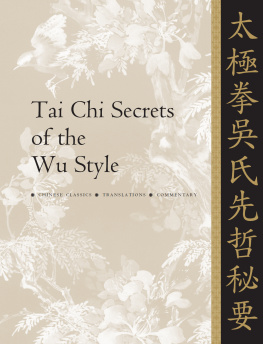
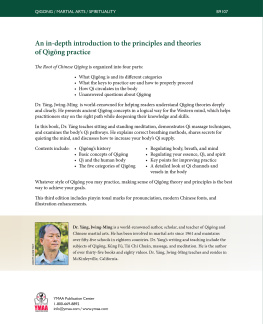
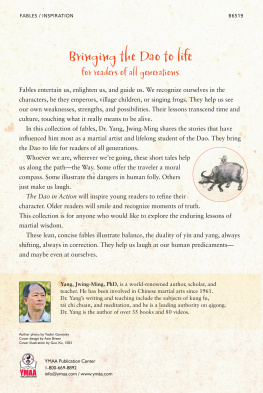
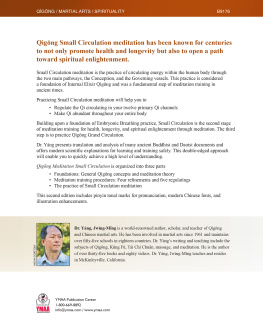


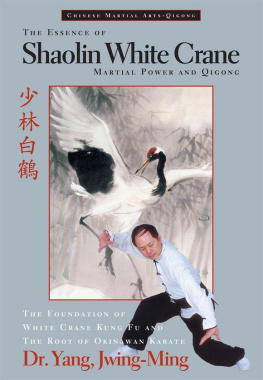
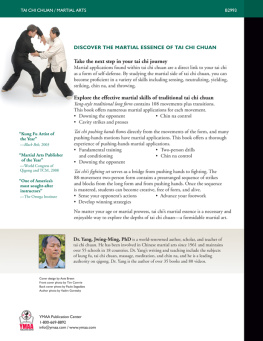
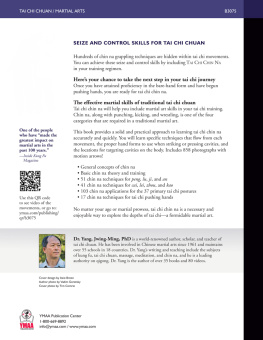
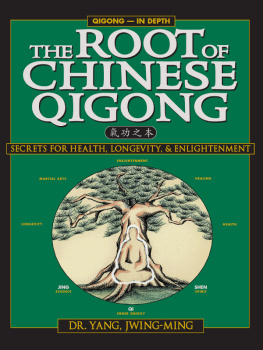
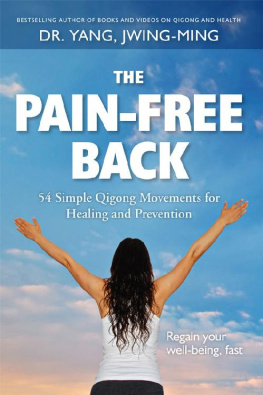


 )(martial arts) is vast and highly diverse. Various schools and styles of Wushu are often categorized into the internal and external varieties. Taijiquan is one of the major divisions of the internal school. Within Taijiquan there are dozens of sub-categories based on the teachings of one Master or a family with generations of experts. The origins of some forms are well documented and reference material is readily available. The Chen (
)(martial arts) is vast and highly diverse. Various schools and styles of Wushu are often categorized into the internal and external varieties. Taijiquan is one of the major divisions of the internal school. Within Taijiquan there are dozens of sub-categories based on the teachings of one Master or a family with generations of experts. The origins of some forms are well documented and reference material is readily available. The Chen ( ) and Yang (
) and Yang ( ) styles which precede the other forms historically have dozens of videotapes, vcd publications, and printed materials available in several languages. Of the five primary family styles of Taijiquan, the Wu style (
) styles which precede the other forms historically have dozens of videotapes, vcd publications, and printed materials available in several languages. Of the five primary family styles of Taijiquan, the Wu style ( )is not as widely practiced in the West as the other forms. Noted for compact structure, gentle and fluid movements, and beautiful balancing techniques, Wu style Taijiquan can provide a solid foundation in many areas: fitness, healing, recreation, personal development and effective self-defense training. The practitioner must have some clear understanding of the basic tenets of the art in order to develop real skills, hence the necessity for the transmission of the essential information by the true Masters of the art. Unfortunately, published material on this style is especially difficult to find.
)is not as widely practiced in the West as the other forms. Noted for compact structure, gentle and fluid movements, and beautiful balancing techniques, Wu style Taijiquan can provide a solid foundation in many areas: fitness, healing, recreation, personal development and effective self-defense training. The practitioner must have some clear understanding of the basic tenets of the art in order to develop real skills, hence the necessity for the transmission of the essential information by the true Masters of the art. Unfortunately, published material on this style is especially difficult to find. )teaching. For many years Dr. Yangs work has informed and inspired martial artists around the world. His translations and insightful commentary afford us the opportunity to delve deeply into the theories and philosophies of prior generations. The Chinese martial arts practitioners of the West owe a great debt of gratitude to Dr. Yang for this and his many other contributions to the development and promotion of our art. There is a famous saying among Chinese Wushu people which begins: Shifu Ling Jin men. (
)teaching. For many years Dr. Yangs work has informed and inspired martial artists around the world. His translations and insightful commentary afford us the opportunity to delve deeply into the theories and philosophies of prior generations. The Chinese martial arts practitioners of the West owe a great debt of gratitude to Dr. Yang for this and his many other contributions to the development and promotion of our art. There is a famous saying among Chinese Wushu people which begins: Shifu Ling Jin men. ( ) (The teacher leads into the door.) Dr. Yang, Jwing-Ming has opened many doors for us. This portal to the essence of the Wu style Taijiquan traditions provides access to hitherto unavailable information, yet again expanding the boundaries of the Chinese martial world.
) (The teacher leads into the door.) Dr. Yang, Jwing-Ming has opened many doors for us. This portal to the essence of the Wu style Taijiquan traditions provides access to hitherto unavailable information, yet again expanding the boundaries of the Chinese martial world.

 ), Taiwan (
), Taiwan ( ), Republic of China (
), Republic of China ( ).He started his Wushu (
).He started his Wushu ( )(Gongfu or Kung Fu,
)(Gongfu or Kung Fu,  )training at the age of fifteen under the Shaolin White Crane (Bai He,
)training at the age of fifteen under the Shaolin White Crane (Bai He,  ) Master Cheng, Gin-Gsao (
) Master Cheng, Gin-Gsao ( ).Master Cheng originally learned Taizuquan (
).Master Cheng originally learned Taizuquan ( )from his grandfather when he was a child. When Master Cheng was fifteen years old, he started learning White Crane from Master Jin, Shao-Feng (
)from his grandfather when he was a child. When Master Cheng was fifteen years old, he started learning White Crane from Master Jin, Shao-Feng ( ), and followed him for twenty-three years until Master Jins death.
), and followed him for twenty-three years until Master Jins death. ), Qin Na (or Chin Na,
), Qin Na (or Chin Na,  ), Tui Na (
), Tui Na ( )and Dian Xue massages (
)and Dian Xue massages ( )and herbal treatment.
)and herbal treatment. ) under Master Kao Tao (
) under Master Kao Tao ( ). After learning from Master Kao, Dr. Yang continued his study and research of Taijiquan with several masters and senior practitioners such as Master Li, Mao-Ching (
). After learning from Master Kao, Dr. Yang continued his study and research of Taijiquan with several masters and senior practitioners such as Master Li, Mao-Ching ( ) and Mr. Wilson Chen (
) and Mr. Wilson Chen ( ) in Taipei (
) in Taipei ( ). Master Li learned his Taijiquan from the well-known Master Han, Ching-Tang (
). Master Li learned his Taijiquan from the well-known Master Han, Ching-Tang (